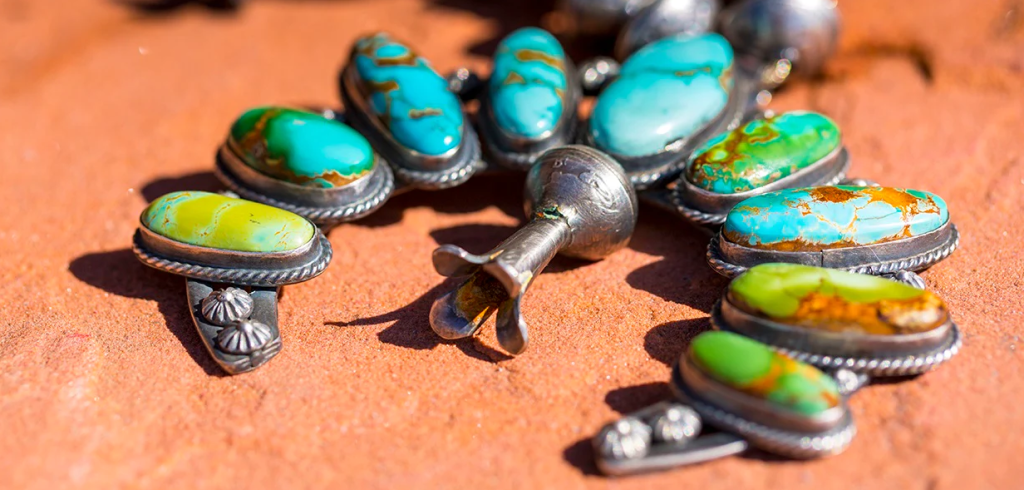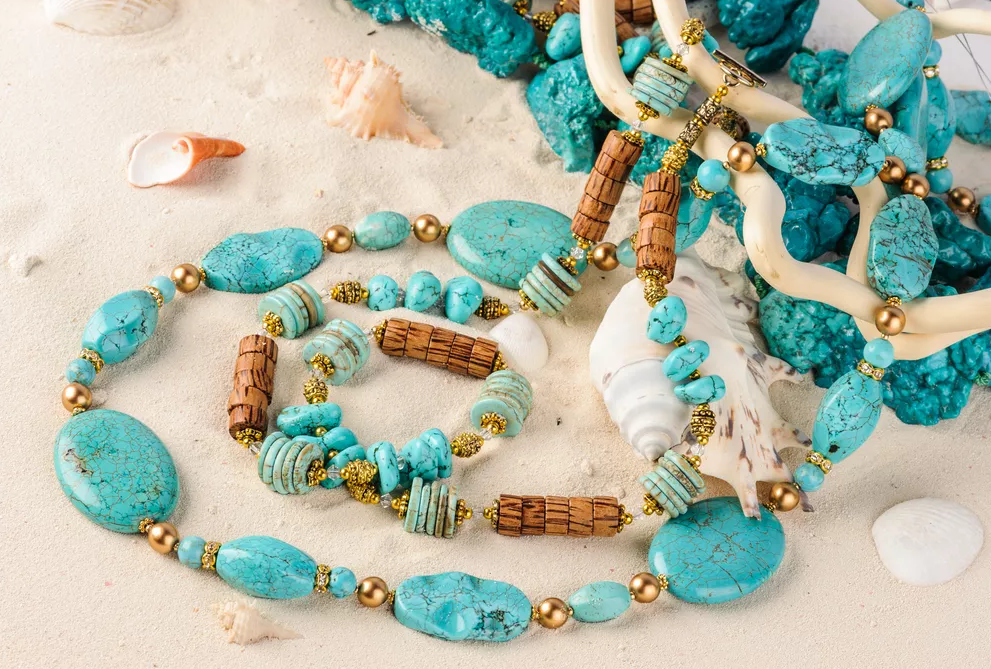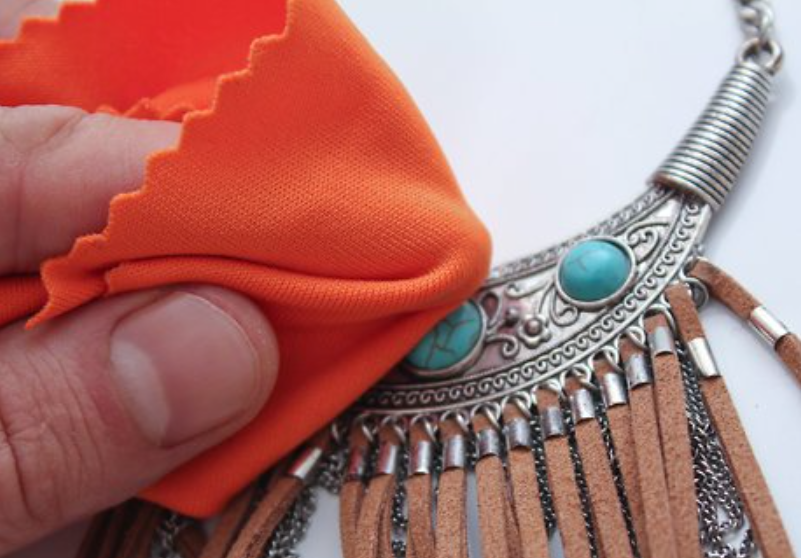Turquoise, with its captivating shades of blue and green, has been revered for millennia, not only for its beauty but also for its mystical properties.
Often embedded in jewelry, this semi-precious stone uniquely captures light, reflecting the vastness of the skies and depth of oceans.
However, over time and with regular wear, the radiant sheen of turquoise can diminish, leaving you wondering how to restore its former glory.
If you’ve stumbled upon an old turquoise gem or piece of jewelry that’s lost its shine, or if you simply want to ensure your treasure remains as lustrous as the day you acquired it, you’re in the right place.
Dive in as we unravel the secrets to rejuvenating turquoise and bringing back its entrancing shimmer.
Understanding Turquoise
Turquoise, with its captivating shades ranging from sky blue to greenish-blue, is not just a visual treat but a gemstone embedded deep in the annals of history, symbolizing power, status, and protection.
Revered by civilizations from the ancient Egyptians to the Native Americans, turquoise has played various roles, from being a talisman for kings and warriors to a ceremonial gem and apotropaic stone, believed to repel negative energy. But what makes turquoise so special? Let’s delve deeper.
Origins and Formation of Turquoise
Turquoise is an opaque, blue-to-green mineral primarily made up of copper, aluminum, and phosphate. It forms when water percolates through pre-existing rocks, usually in arid regions, and reacts with certain minerals, creating turquoise deposits.
Formation Environment: Turquoise usually forms in arid regions where groundwater is sparse. This scarcity is essential as it allows for the slow buildup of the minerals required to form turquoise.
Role of Copper: The stunning blue hue of turquoise is attributed to the presence of copper in its composition. When there’s a higher concentration of copper, the stone generally appears bluer. Conversely, the presence of iron in the mix can lead to a greener shade.
Associated Minerals: Turquoise often forms in close association with other minerals, particularly in the crevices of rocks. Hence, it’s not uncommon to find turquoise with intricate, spidery veins of host rock, termed as the matrix. This matrix, which can be black, brown, or a mix of colors, adds character to the stone, with some patterns being particularly sought after.
Properties That Make Turquoise Unique
Color Spectrum: Turquoise can range in color from pure sky blue to apple green. The range in color is primarily due to the variations in its copper and iron content.
Mohs Hardness: It ranks between 5 to 6 on the Mohs scale of mineral hardness. This relatively soft nature makes turquoise suitable for carving and crafting intricate jewelry designs but also requires extra care to prevent scratching.
Porosity: Turquoise is naturally porous, making it vulnerable to chemicals and even skin oils. Over time, contact with these elements can alter their color.
Matrix Patterns: The matrix, or the web-like pattern found on some turquoise stones, is unique to each piece, much like a fingerprint. This can make certain pieces, especially those with an attractive spider-web matrix, more valuable.
Difference Between Stabilized and Natural Turquoise
When shopping for turquoise or admiring a piece, it’s essential to understand the difference between stabilized and natural turquoise.
- Natural Turquoise: As the name implies, this is turquoise in its natural state. It has not been treated or enhanced in any way. Natural turquoise is often softer and can be more susceptible to damage and changes in color over time due to its porosity.
- Stabilized Turquoise: To enhance the durability and preserve the color of turquoise, some stones undergo a stabilization process.
During this process, the turquoise is permeated with a clear resin, which makes it harder and less porous. Stabilized turquoise is more resistant to scratches and less affected by oils or chemicals. However, purists may prefer the untouched beauty and rarity of natural turquoise.
Turquoise is a mesmerizing stone, prized not only for its aesthetics but also for its deep-rooted history and cultural significance. By understanding its origins, unique properties, and the differences between its natural and stabilized forms, one can truly appreciate the allure and value of this ancient gem.
Reasons Turquoise Loses Its Shine
Turquoise can lose its lustrous shine over time and with exposure to various elements. This section delves into why turquoise may lose its gleam and offers steps to restore its brilliance.
1. Exposure to Chemicals, Cosmetics, and Body Oils
Chemicals: Everyday household chemicals, including cleaning agents, can cause discoloration or damage to the stone.
Cosmetics: Lotions, perfumes, and other beauty products contain compounds that may dull the turquoise’s surface when they come into contact with the gem.
Body Oils: Natural oils from our skin can accumulate on the turquoise over time, reducing its shine and clarity.
Swimming Pools: The chlorine used in swimming pools is particularly harmful to turquoise and can quickly diminish its natural sheen.
Medications: Sometimes, the residue of certain medications that are excreted through the skin can negatively interact with turquoise.
2. Harsh Cleaning Methods
Strong Detergents: Using strong soaps and detergents can strip turquoise of its natural shine.
Ultrasonic Cleaners: These can cause tiny fractures in the stone, making it appear less vibrant.
Abrasive Scrubbing: Physical scrubbing with harsh materials can scratch and damage the turquoise’s surface.
Wrong pH Balance: Using cleaning agents that are too acidic or alkaline can harm the stone.
Inappropriate Cleaning Tools: Brushes that are too hard can leave scratch marks on the gem.
3. Physical Abrasion and Natural Wear
Daily Wear: Simply wearing turquoise jewelry on a regular basis can expose it to elements that cause wear and tear.
Contact with Hard Surfaces: Accidental knocks against tables, walls, or other hard surfaces can result in scratches.
Dirt and Grime: Over time, accumulated dirt can abrade the stone’s surface.
Improper Storage: Storing turquoise with other harder gemstones can lead to scratches and chips.
Continuous Use: Wearing turquoise during strenuous activities can increase the chances of it getting scratched or damaged.
4. Environmental Factors: Humidity, Temperature, and Light Exposure
Humidity: Excessive humidity can lead to changes in turquoise’s color or surface texture.
Temperature Fluctuations: Sudden changes in temperature can cause stress fractures in the gemstone.
Direct Sunlight: Prolonged exposure to direct sunlight can fade its vibrant blue-green color.
Air Pollutants: Polluted air can react with the minerals in turquoise, leading to discoloration.
Exposure to Saltwater: Saltwater can corrode the turquoise and reduce its sheen.
By understanding the reasons behind the fading shine of turquoise, you can take proactive steps to prevent its deterioration and keep it gleaming for years to come. The next sections will provide insights and guidelines on reviving and maintaining this magnificent gemstone’s luster.

Preliminary Steps Before Cleaning
1. Checking the jewelry setting (if the turquoise is set in jewelry)
Ensure Secure Settings: Before cleaning, it’s essential to verify that the turquoise is securely set in the jewelry piece. Any loose settings can lead to the stone falling out during cleaning.
Metal Examination: Examine the type of metal the turquoise is set in. Some metals require different cleaning methods, and the cleaning process for the stone might damage certain metals.
Examine for Additional Stones: If your jewelry piece has other gemstones alongside the turquoise, consider their care requirements as well. Some stones are more delicate and might need different treatments.
Backings and Closures: Inspect backings, clasps, and closures for functionality. Cleaning might interfere with broken or weak parts.
Avoid Aggressive Cleaning: Some jewelry settings are intricate and aggressive cleaning can alter the design. Always opt for gentle cleaning methods.
2. Identifying any cracks or weak spots
Physical Inspection: Before cleaning, visually inspect the turquoise for any visible cracks or chips.
Touch Test: Gently run your fingers over the turquoise. If you feel any uneven surfaces, this could indicate weak spots.
Avoid Water: If there are cracks, avoid submerging the stone in water as this can exacerbate the damage.
Limit Mechanical Cleaning: Ultrasonic cleaners and steamers can worsen existing cracks, so it’s best to avoid them if cracks are present.
Seek Professional Help: If your turquoise has significant cracks, it might be best to consult a gemologist or professional jeweler before attempting any cleaning.
3. Differentiating between stabilized and natural turquoise and why it matters
Stabilized vs. Natural: Stabilized turquoise has been treated with resins to make it more durable, while natural turquoise has not undergone any such process. Knowing the difference is essential as their care varies.
Cleaning Sensitivity: Natural turquoise is more porous and sensitive to chemicals and liquids compared to stabilized turquoise.
Durability: Stabilized turquoise, due to its treatment, can often withstand more rigorous cleaning methods.
Luster & Shine: Natural turquoise might lose its shine more easily but also regains its luster more naturally. Stabilized turquoise, once it loses its shine, might require professional re-polishing.
Avoiding Damage: Always default to gentler cleaning methods if unsure of your turquoise’s nature. Harsh chemicals can irreparably damage natural turquoise.
Methods to Restore Shine to Turquoise
For Natural Turquoise
- Gentle Cleaning with Lukewarm Soapy Water: Over time, the turquoise stone can accumulate dirt, dust, and oils. Prepare a mild solution of lukewarm water and a few drops of mild dish soap. Soak the stone for a few minutes and gently swish it around.
- Using a Soft Brush for Scrubbing: Sometimes, the grime is hard to remove with just soaking. In such cases, use a soft-bristle brush like an old toothbrush to gently scrub the stone. Ensure you do this gently to avoid any scratches.
- Drying Techniques: Once cleaned, avoid leaving the stone wet. Pat dry it using a soft cloth. Ensure it is completely dry before storing, as trapped moisture can damage the stone.
- Regular Maintenance: Making a habit of cleaning your natural turquoise periodically will keep it shiny and lustrous. Ensure you do this at least once a month, or after heavy use.
- Avoid Harsh Chemicals: Chemicals found in cleaners, perfumes, and even lotions can tarnish the shine of your natural turquoise. Make sure to keep these substances away from the stone.
For Stabilized Turquoise
- Cleaning Agents to Avoid: Stabilized turquoise has been treated with resins and other materials to enhance its durability. Avoid using acidic solutions, bleach, or ammonia-based cleaners which can react with the stabilizing materials.
- Gentle Polishing with a Soft Cloth: Stabilized turquoise might lose its gleam due to surface scratches. Use a soft microfiber cloth to gently polish the surface and restore its shine.
- Reapplying Protective Sealant, if Necessary: If your stone starts looking too dull or feels porous, it may need a reapplication of a protective sealant. This will fill up any microscopic pores and give a polished appearance.
- Avoiding Heat: Excessive heat can harm the stabilizing agents in turquoise. Keep the stone away from direct sunlight or heated areas.
- Handling with Care: Stabilized turquoise is more durable than its natural counterpart but still requires gentle handling. Avoid dropping it or knocking it against hard surfaces.
Turquoise Jewelry
- Using Jewelry Polishing Cloths: Invest in quality jewelry polishing cloth. These are specially designed to restore the shine in gemstones without causing any damage.
- Avoiding Ultrasonic Cleaners and Steam: These cleaning methods can be too harsh for turquoise jewelry, causing cracks or affecting the stone’s integrity.
- Proper Storage Methods to Retain Shine: Always store turquoise jewelry separately, preferably in a soft cloth pouch or a jewelry box with separate compartments. This prevents it from getting scratched by other pieces.
- Wear with Care: When wearing turquoise jewelry, make sure to put it on after applying cosmetics, hairspray, or perfumes. These can dull the stone’s shine.
- Regular Maintenance: Just as with natural turquoise, periodic cleaning using the methods above can help retain the shine of your turquoise jewelry.
Reviving the turquoise shine requires gentle care, proper maintenance, and awareness of what might damage the stone. With the methods described above, your turquoise can retain its luminous beauty for years to come.

Maintenance Tips to Prevent Dullness
The brightness of your turquoise can diminish over time due to various factors, but with the right preventive measures, you can ensure its longevity and luster. In this section, we’ll delve into maintenance tips that can help you prevent dullness and keep your turquoise shining bright.
1. Regular Gentle Cleaning
To maintain the shine and radiance of turquoise, it’s essential to clean it regularly. However, one must be cautious about the method:
- Mild Soap Solution: Mix a few drops of mild dish soap with warm water and gently clean the turquoise using a soft cloth or brush.
- Avoid Harsh Chemicals: Chemicals can cause discoloration. Always opt for a mild cleaning agent.
- Rinse Thoroughly: Ensure all soap residues are washed off the stone.
- Air Dry: Let your turquoise jewelry air dry completely before storing.
- Avoid Ultrasonic Cleaners: These can be too harsh for turquoise and may cause damage.
2. Avoiding Direct Sunlight and Excessive Heat
Turquoise is sensitive to prolonged exposure to sunlight and heat:
- Natural Color: Extended exposure can cause the stone’s color to fade or change.
- Temperature Shifts: Sudden temperature changes can cause the stone to crack.
- Safe Spot: Store your turquoise pieces in a cool, shaded place.
- Limit Sun Exposure: Don’t wear turquoise jewelry during long hours in direct sunlight.
- Avoid Heat Sources: Keep turquoise away from heaters, stoves, and other direct heat sources.
3. Keeping Turquoise Away from Cosmetics, Perfumes, and other Chemicals
To maintain its shine:
- Apply First, Wear Later: Always wear makeup, perfume, and hairspray before wearing turquoise jewelry.
- Limit Exposure: Some lotions and creams contain chemicals that can tarnish or discolor the stone.
- Clean After Wear: After removing your jewelry, wipe it down to remove any residual chemicals.
- Mind Swimming: Chlorine in swimming pools can adversely affect turquoise. It’s best to remove turquoise jewelry before taking a dip.
- Household Chores: Remove turquoise rings when using household cleaning agents.
4. Proper Storage Solutions
To keep your turquoise shiny:
- Separate Pouches: Store turquoise in individual soft pouches to prevent scratches from other jewelry.
- Avoid Plastic Bags: Some plastics emit chemicals that can tarnish turquoise over time.
- Climate Control: Keep your turquoise in a location with consistent temperature and humidity.
- Away from Direct Light: As mentioned, prolonged sunlight can fade the stone’s color.
- Layer Softly: If storing in a jewelry box, place a soft cloth beneath and over the turquoise pieces.
5. Recommendations for Wearing Turquoise Jewelry to Minimize Exposure to Harmful Elements
When wearing your precious turquoise:
- Last On, First Off: Turquoise jewelry should be the last thing you put on and the first thing you take off.
- Beware of Physical Work: Avoid wearing turquoise during activities like gardening or gym workouts to prevent physical damage.
- Limit Outdoor Exposure: It might be best to leave your turquoise at home if you’re spending a day at the beach or hiking.
- Travel with Care: If traveling, ensure your turquoise is securely packed and not subjected to excessive jostling.
- Regular Check: Periodically check the settings of your turquoise jewelry to ensure the stone is secure.
By incorporating these maintenance tips, you’ll prevent dullness and ensure that your turquoise retains its captivating allure for generations to come.
Warning and Precautions
1. Being cautious about commercial jewelry cleaners
Jewelry cleaners might seem like a one-size-fits-all solution, but they often contain chemicals that can be harmful to turquoise. Before using any cleaner, consider the following:
Harsh Chemicals: Many commercial jewelry cleaners contain strong chemicals that can strip the natural oils from turquoise, making it appear dull and lifeless.
Abrasive Components: Some cleaners include abrasive elements to scrub dirt and grime away. These can scratch the surface of your turquoise.
Loss of Natural Luster: Over time, the repeated use of these cleaners can erode the turquoise’s natural shine and potentially damage it beyond repair.
Unpredictable Reactions: Turquoise, depending on its origin and treatment, can react unpredictably with certain chemicals, causing discoloration or degradation.
Safe Alternatives: If you must use a cleaner, opt for a mild, natural solution. A gentle mix of water and mild soap can often do the trick for turquoise.
2. Understanding the fragility of turquoise
Turquoise is considerably softer and more porous than many other gemstones. This inherent fragility necessitates additional care:
Soft Nature: With a rating of 5-6 on the Mohs scale, turquoise is susceptible to scratches and dents.
Porous Surface: The porous nature means it can absorb oils, lotions, and other substances, which can change its color and sheen.
Avoid Hard Impacts: Dropping turquoise or banging it against a hard surface can cause chipping or fractures.
Exposure to Sunlight: Prolonged exposure to direct sunlight can cause the turquoise color to fade.
Be Mindful with Water: While a little water for cleaning is okay, prolonged exposure can weaken the stone or alter its appearance.
3. Importance of regular inspections for wear and damage
Routine checks can help preserve the beauty of turquoise and identify potential issues before they become serious:
Early Detection: Regularly inspecting your turquoise jewelry can help you catch minor damages early on, potentially preventing more severe damage.
Professional Cleaning: Sometimes, a professional touch is required. Jewelers have the expertise and tools to safely clean and polish turquoise without causing harm.
Assessing Mountings: If your turquoise is set in a piece of jewelry, ensure the mountings and prongs are secure. Loose settings can lead to lost stones.
Looking for Changes: Regularly check for any changes in color, shine, or surface texture. These could be signs of exposure to harmful substances or environmental factors.
Storage Check: Storing turquoise properly is essential. Keep it away from other jewelry items that might scratch it and avoid storing it in overly humid or dry environments.
Conclusion
Restoring the luster and vibrancy of turquoise jewelry is an endeavor that combines gentle care with proven techniques. As we delved into the methods that can make turquoise shiny again, it’s evident that protecting this delicate gemstone from potential harm is as essential as knowing how to rejuvenate its shine.
From cleaning with mild soapy water to avoiding harsh chemicals and ensuring it’s stored safely, a little attention goes a long way in maintaining the captivating allure of turquoise.
Whether you’re a seasoned collector or someone who’s recently acquired a piece of turquoise jewelry, remember that its beauty is timeless. By following the guidelines mentioned in this article, you can ensure that your turquoise remains as radiant as the first day you laid eyes on it.



